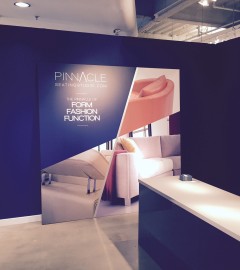
Retail design veteran Martin Roberts reported that he recently worked with Palliser Furniture to create an environment to set apart the manufacturer’s luxury brand—Pinnacle Seating Studio—both within the showroom and on retail floors.
The challenge: To design the elements that would create a special environment at retail to properly showcase the luxury brand and set it apart from the remainder of the store, and to let shoppers know that great function is “hidden” within Pinnacle’s sleek, fashion-forward silhouettes.
Published first in Furniture World.
“Most of the time, when you look at a European contemporary sofa with motion functions in a room setting, it looks no different from a stationary piece,” Roberts says, “especially when the buttons or releases are unobtrusive or purposely hidden in the design. Unless the sofa is articulated and reclined so the footboard is out and the headboard is down, shoppers have no way to know that they are looking at something that moves.”
While Roberts has been encouraging retailers to leave motion pieces in an open mode on their floors so that people can actually see how they work, he admits the idea has met with resistance. Mainly, because aesthetically speaking, no matter how stylish and sexy, motion pieces don’t look as appealing open as they do when closed.
To solve the problem, Roberts has created flexible signage. “Martin is helping us find ways to make the Pinnacle product stand out on the floors of some of the better-known Palliser retailers,” Jessica Smithson, Palliser Furniture marketing manager, relates. “We want to make sure that Pinnacle fits into their spaces seamlessly and that there is signage using our beautiful room photography that encourages shoppers to come over and experience the product. We’re very excited about the solution he’s created, because it’s really low-maintenance and easy-to-install, but very high impact. They support the product, but don’t overshadow it. The graphics are really simple and show the product in room environments, but in their simplicity, clearly get the message across about what the furniture does. At the same time, the signage is very flexible, because we realize that some retailers have more placements on their floors than others.
For his part, Roberts says the point-of-purchase materials not only support the product on the floor, but add to the story by showing what’s possible beyond what is seen on the floor. “Martin really knows how consumers shop a floor,” Smithson says, “and he understands what retailers’ expectations are for the business. He has great insight into how we can fit into those expectations and be good partners.”